2018 Ford Mustang GT vs. EcoBoost Review
Can Ford’s most uncompromising car win over a mom, a millennial, a commuter and a car guy?
 Aaron Miller
Aaron Miller
Mustang’s legacy dates back to 1964, when Ford unveiled the original “Pony Car” and quickly established a new standard for two-doored sportiness and affordability. While the car itself has evolved over the last four decades, Mustang’s DNA remains intact: It is about as pure Americana as cars get.
Apple Pie in motorized form.
In a sense, Mustang’s ethos is so strong that the ongoing challenge for Ford is to find ways to broaden the appeal of its quintessential muscle car without alienating its devoted fans – the kids who grew up with posters of Mustangs on their walls and the Baby Boomers who still reminisce about their beloved fastback in the driveway.
Can the designers in Dearborn freshen the Mustang, now in the midst of its sixth generation, enough to satisfy a car guy, and a commuter, and a millennial, and a soccer mom?
That was one of the questions we set out to answer when we enlisted that veritable breakfast club of drivers (more on them,
- A Shadow Black GT, which starts at just over $35,000 and brings with it the car’s signature V8 rumble, and
- A bright orange EcoBoost, the four-cylinder fastback that’s easier on fuel and your wallet, if not your eyes
Over two weeks on the busy toll roads and city streets of Dallas-Fort Worth, our quartet drove both vehicles. Along the way, we discovered things about ourselves and the cars that challenged conventional wisdom. We were also evenly split on whether we preferred the GT or EcoBoost.
But one conclusion was unanimous: you either inherently buy into the Mustang’s reason for being, or you don’t. It really is that simple. You buy a Mustang because no combination of options and specs on any other car will make up for its intangibles.
Being a Mustang is its calling card.
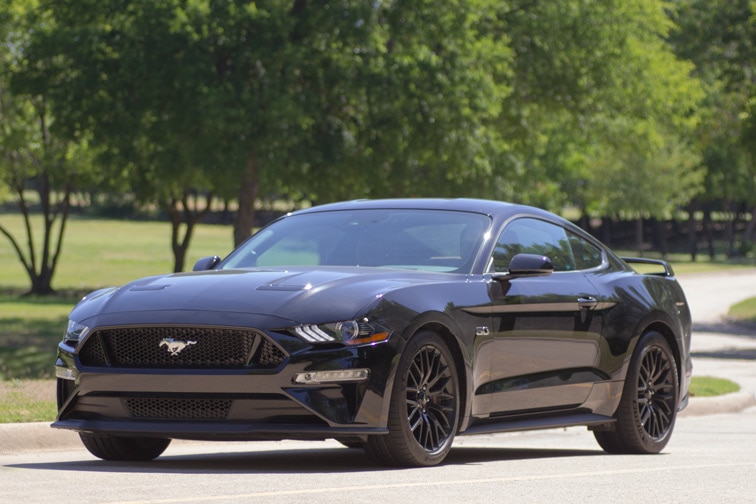 Aaron Miller
Aaron Miller
MUSTANG GT
- Base Price: $35,190
- Trim Tested: Premium (MSRP $39,190, $50,155 with options)
- Weight: 3,705 lbs.
- Engine: 5.0L V8 with 460 hp and 420 lb.-ft. of torque
- EPA Estimated Fuel Economy: 24/15/18 mpg (hwy/city/comb.)
- Pros: This is the all-singing, all-dancing Mustang experience, full of sound and fury, symbolizing Mustang.
- Cons: Optional extras can send the price north of $50,000, which both starts to encroach on Shelby territory, and brings the affordability factor down a notch.
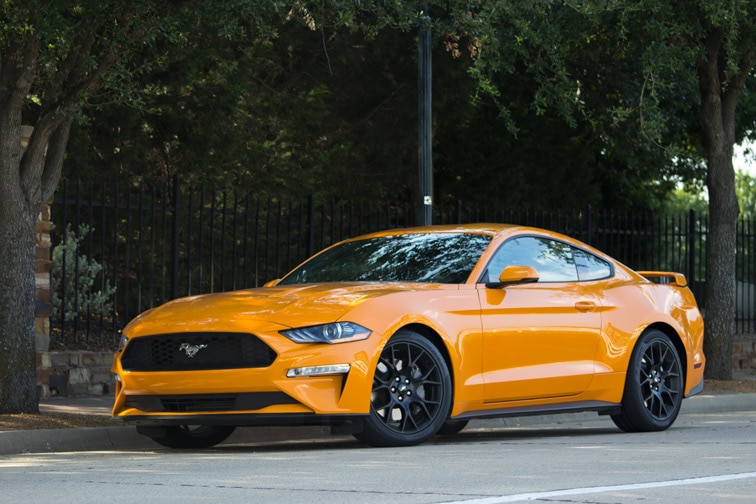 Aaron Miller
Aaron Miller
MUSTANG ECOBOOST
- Base Price: $25,680
- Trim Tested: Premium (MSRP $30,695, $41,670 with options)
- Weight: 3,532 lbs.
- Engine: 2.3L EcoBoost 4-Cylinder with 310 hp and 350 lb.-ft. of torque
- EPA Estimated Fuel Economy: 31/21/25 mpg (hwy/city/comb.)
- Pros: Mustang looks, good handling, and surprising power at a palatable price.
- Cons: No matter how quick it is, it’s not a GT, and it never will be.
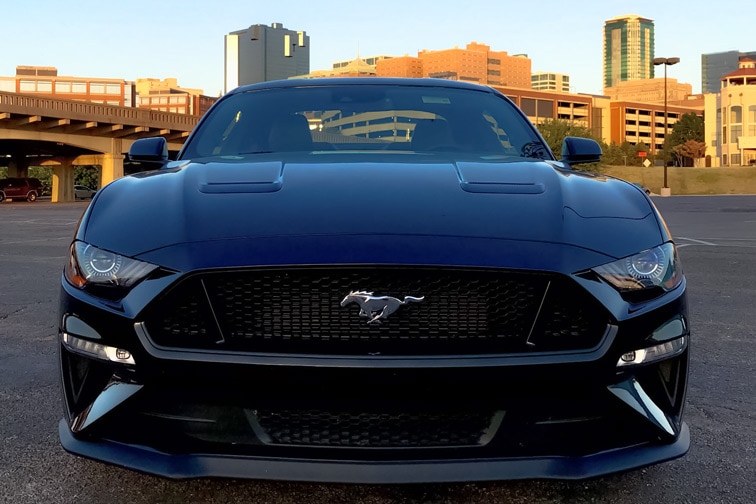 Rick Press
Rick Press
THE LOOK AND FEEL
Mustang brings with it an awful lot of drama, which lends the car an unmistakable visual (and in the case of the GT, aural) presence. It starts with the classic Mustang “fastback” silhouette, which has the rare trait of looking good in any color. Case in point: our resident Millennial described the EcoBoost’s Orange Fury paint job as a “bright shade that grows on you like a colorful fungus.” Before handing back the keys, he adored it. Others preferred the GT’s black hue, finding it more sleek and seductive.
Power, of course, has long been a fundamental ingredient in V8 Mustangs, and our Commuter experienced a gleeful return to his teenage years behind the wheel of the GT, due in no small part to the car’s ability to “get around left-lane lollygaggers.”
The Mom of the group observed that the GT still feels like the Mustangs of her youth, albeit quicker and with more power and creature comforts. She also noted a sense of pride walking up to the GT in a parking lot. And that’s a crucial point: Even at a standstill, the car projects a unique Mustang persona – sometimes literally, as is the case with the Premium trim’s pony-shaped puddle lights (top right, below), which are an object of fascination the first time almost anyone lays eyes on them.
 Aaron Miller / Rick Press
Aaron Miller / Rick Press
The Enthusiast observed a fair amount of detail work, the kind of thing you’d only really appreciate once the novelty of ownership wears off. Tri-slotted headlights and directional tail lights pay tribute to some of Mustang’s legendary 1960s ancestors, just as hood vents evoke memories of turn-of-the-century Mustang Cobras. The various cues merge into a cohesive look that’s equal parts motoring heritage and modern muscle.
Unlike some previous generations of Mustang, there’s little to distinguish the GT from the EcoBoost on the outside. Keen eyes will note badges on the fenders and trunk lid, and our GT tester featured aggressive-looking quad tailpipes – a visual clue to Ford’s electronically variable exhaust, which allows you to choose from several levels of noise.
 Aaron Miller
Aaron Miller
IT'S WHAT'S INSIDE THAT COUNTS
The interior is a melting pot of vintage Mustang, aircraft, and modern technology. Regardless of the model you’re in (GT or EcoBoost), there are two options for gauges, starting with a twin-barrel analog cluster that provides easy-to-read information with an old-school style. The optional digital panel offers complete customizability, down to changing the basic layout from traditional round gauges in “normal” mode, to background colors, to sport and track settings that alter the way the information appears on screen. Our testers were split on this, with two admiring the sentimentality of the analog gauges, our Millennial deferring to modern modularity, and our Enthusiast – despite an initial affinity for the old-school design – ultimately falling for the customization options and what he described as "better readability."
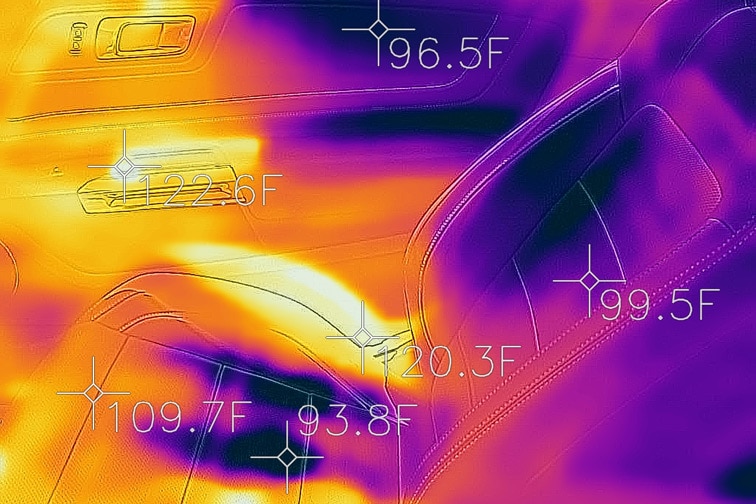 Aaron Miller
Aaron Miller
The tactile elements of Mustang are compelling, too. Our Commuter loved the steering wheel for its “thick and leathery” feel that aligned perfectly with his notion of what a muscle car should be. All agreed that not only did the premium trim’s leather seats do an admirable job of holding occupants in place during spirited driving, but that the seat ventilation feature is an absolute must for anyone living in warmer climates. In testing, seat surface temperatures cooled by over 30 degrees in just a few minutes – think of it as having all the benefits of pointing your posterior at an air conditioning duct, without the confused stares from passers-by.
 Aaron Miller
Aaron Miller
In terms of practicality, well, it’s a Pony Car, which means such considerations will always take a back seat to style. Our Commuter longed for a bit more interior storage space and another cup holder or two. Our resident mother of two was unable to squeeze a full-sized baby seat through the opening behind the front seat, and she found the doors to be long and heavy. The sweeping roofline that gives Mustang its sleek look means that, for anything longer than a lunchtime jaunt, the back-seat is best limited to small children, backpacks, and the like. Trunk space, however, is more than adequate for fitting a couple of golf bags: at 13.5 cu.ft., it skews more towards the Camry end of the spectrum (15.1 cu.ft.) than Camaro (9.1 cu.ft.).
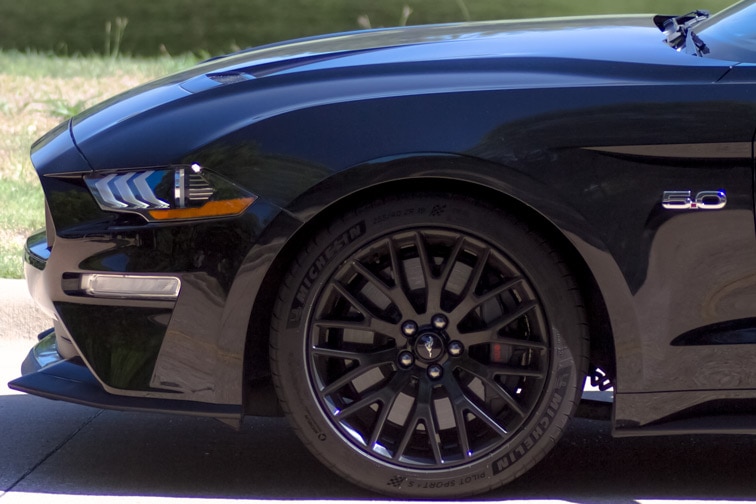 Aaron Miller
Aaron Miller
THE DRIVE
Both of our Mustangs came with the optional performance package and active suspension, which bends the rules of physics to improve both handling and ride at the same time. Without getting bogged down in the technical bits, the shock absorbers are filled with what’s called magnetorheological fluid, which for all intents and purposes, thickens instantaneously when an electrical charge is applied. The end result is a just-as-instantaneous adaptation to prevailing road conditions and better control from the driver’s standpoint.
All four of our drivers noted surprise at how smooth both Mustangs were over speed bumps. Our Commuter was impressed with the stability at highway speeds and felt as if the car was begging him to go faster. Our Enthusiast, meanwhile, appreciated the cars’ planted rear end over undulating pavement.
The real party trick is the suspension’s ability to stiffen on demand, in concert with a stiffer steering feel, a more sensitive accelerator, and a louder exhaust note, courtesy of a not-so-innocuous switch on the dashboard. “Normal” mode is just that – the softest, quietest level of Mustang. “Sport” and “Track” ratchet things up a notch or two, and for everyone, the majority of miles were covered in Sport.
And that’s where opinions of the two cars really diverged. Two of us were charmed by the V8’s intoxicating aural assault, with one of our testers going so far as to say that by comparison, the EcoBoost felt more like an ordinary sedan – especially in “Normal” mode. Our Enthusiast, unsurprisingly, found himself pining for a manual transmission, having found the state-of-the-art 10-speed transmission to be good, but not inspiring. Our other testers expressed similar opinions, with the largest complaint being jerky shifts and hesitation during city driving.
Obviously, the GT is the faster of the two in a straight line – the 460 hp, 5.0L V8 engine lying in wait under the hood makes sure of that – but it’s also the heavier car by about 170 pounds. Because almost all that extra weight is in the front of the car, the GT is a little less responsive when turning a corner.
The EcoBoost is no slouch in a straight line, itself, with more than enough torque for all but the most lead-footed drivers (350 lb.-ft., compared to the GT’s 420 lb.-ft.), and because of the lighter front end, it’s the more enthusiastic corner carver. At just over 3,500 lbs., it’s still a blast on roads that are less-than-straight. Regardless of the engine choice, there’s no denying that this generation of Mustang is far and away the best-handling pony car ever produced by Ford.
THE FINAL TAKE
Our panel was split as to which car we’d pick if money was a factor. Both our Commuter and Mom championed the GT. The “full-on muscle car” effect of the sound and effortless acceleration was enough to make them fall in love with driving a Mustang, despite their previously stated desires for practicality. In the words of the Commuter: “I’m not a muscle car guy, but driving the GT for a couple of days made me think I could be.”
The EcoBoost found support from both the Millennial and the Enthusiast…and each had different reasons. The lower temptation of excessive acceleration appealed to our Millennial, who developed a real concern for his ability to maintain his license. The Enthusiast, however, found the lighter front end more conducive to taking corners in his daily drive, and found it a somewhat more user-friendly car when driving in a spritely manner.
Ultimately, if you want a car that’s uncompromisingly and unapologetically a Mustang, the GT might very well be worth the nearly $10,000 premium over a comparably-equipped EcoBoost. If, on the other hand, you can live without the all-American aural accompaniment but still desire an able-handling sports coupe dripping with heritage, the EcoBoost is hardly second fiddle.
WHO WE ARE:
- The Millennial: Drives the same vehicle he bought upon completing law school. Appreciates the thought that goes into a car’s design, but isn’t emotionally attached to any specific automotive brand. Could live without a vehicle if mass transit were a viable option.
- The Commuter: After a couple decades in journalism, he values the practicality and economy of a basic conveyance in the grueling 50-mile fight against rush hour traffic he faces twice a day.
- The Mom: She loves driving a sporty car as much as the next…so long as her whole family can come along. Fun is great, but it takes a back seat to practicality and her two young children.
- The Enthusiast: Enjoys being behind the wheel far more than long walks on the beach. Dedicated his life to all things automotive, and has driven everything from minivans on a race track to supercars in traffic, and vice versa.
Written by humans.
Edited by humans.
 Aaron Miller
Aaron MillerAs a veteran automotive journalist, I have been fortunate enough to drive some of the most desirable cars on the planet and get to know some of the most important people in the industry. Before joining Capital One, I served as the Cars Editor for a major national website, and covered industry news and analysis for well-known automotive-specific sites. I also wrote feature articles and reviews for niche enthusiast websites. I’ve been obsessed with cars since—literally—before I can remember, with my collection of die-cast and slot cars taking center stage during my formative years. Simply put, for me, working isn’t really “work.”
Related articles
View more related articles